Mercado de San Miguel: Ultimate Eating & Drinking Guide
Aug 31, 2019
The Mercado de San Miguel is on every Madrid visitor’s to do list. And for good reason – it’s the home to an incredible array of Spanish food, it’s smack bang in the centre of Madrid, and it can be a hell of a fun place to visit.
But stepping into the market can also be an overwhelming experience. It’s often packed to the gills, there’s so much choice (over two dozen stalls!), and not everything on offer is great (or Spanish).
So in this Ultimate Guide to the Mercado San Miguel I want to give you the tips and tools you need to have an amazing and delicious experience.
I also made a video where I try some of the best food in the market, and also reveal a few stall to avoid.
Where is the Mercado de San Miguel?
The Mercado de San Miguel is right in the centre of Madrid. It’s alongside the famous Plaza Mayor, and about a 5 minute walk from the Puerta del Sol. The best Metro stop for getting to the market is Sol.
3 Frequently Asked Questions About the Mercado de San Miguel
Before you even go to Madrid’s most famous market, there are few key things to keep in mind. Here are the answers to three of the most common questions I get about the Mercado de San Miguel.
1. Is it a traditional market?
No—it’s more of a gourmet food hall. Traditional Spanish food markets are where locals do their grocery shopping, and you won’t find that at the Mercado de San Miguel.
However, Madrid still does have plenty of traditional markets. A few of my favourites are the Mercado de Antón Martín (check out this video I did about that market), Mercado de la Paz, Mercado de San Fernando and Mercado de Maravillas.
Note: The market once was a traditional market. It was built in 1916 as a local market for residents (based on the cast-iron style of European markets of the time – particularly Les Halles in Paris). But in the 1990s the market began a slow decline as people started going to supermarkets (and, I assume, as residents moved out of the centre of Madrid and into the surrounding neighbourhoods). So it was snapped up by some investors, closed for remodelling and reopened in 2009 as the gourmet food hall it is today.
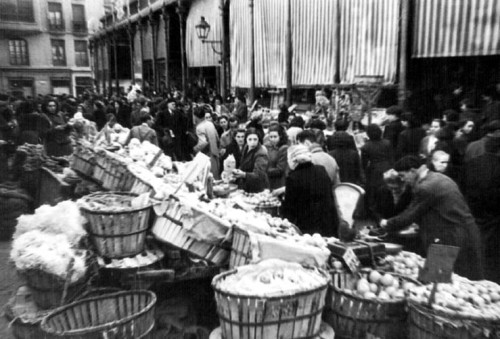
THE MERCADO DE SAN MIGUEL IN FULL SWING IN 1940 (SOURCE: RUTASMADRID)
2. Is it touristy?
Yes, but for a good reason. It’s got a prime location right in the heart of Madrid, just outside the Plaza Mayor. It’s possibly the only place in the city where you can try all sorts of foods from all over Spain all under one roof.
Simply put, It’s got all the right ingredients (pun intended) for a popular attraction—particularly one aimed at hungry visitors.
Spaniards do sometimes visit the market (often to bring friends who are visiting), but you will find it’s mainly tourists. But that doesn’t mean the quality isn’t good. It just means it’s a little more expensive than other tapas bars, and, well, you’ll have a lot of tourists around you.
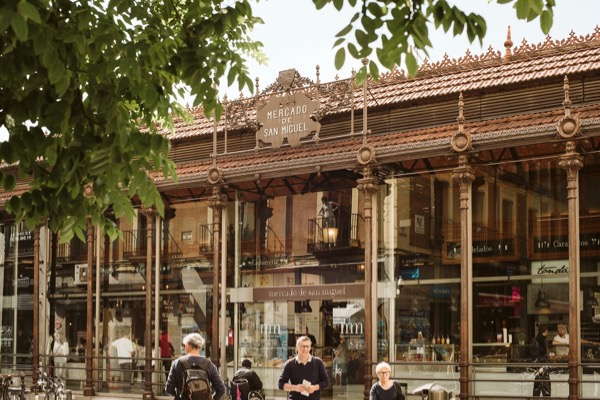
3. When is the best time to visit?
The Mercado de San Miguel is open from 10 a.m. until midnight (and 1am on Friday and Saturday nights). Food is served this entire time: you can get a cup of coffee in the morning, and a nightcap at night.
According to a vendor I spoke with, peak hours are generally from 12–3 p.m. and again from 7:30–10:30 p.m. If you really want to experience the market at its most active, go during these times,.
But beware, it can get really, really busy, making it hard to get to some of the stalls and really challenging to find a surface to put your food down on. So if you’d rather have a quieter experience, head there during off-peak hours.
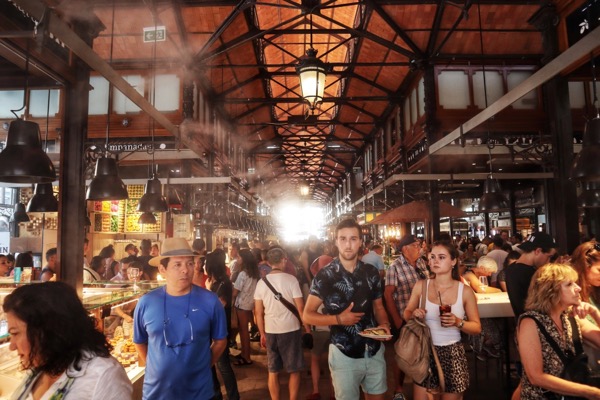
IT CAN GET BUSY IN THE MERCADO DE SAN MIGUEL
3 Tips For Visiting the Mercado de San Miguel
1. Take a walk with your drink
When you order a drink at any of the stalls in the market, you’re free to walk around the market with it. So, a great way to start your Mercado San Miguel experience is to grab a drink (I suggest a vermouth – see below!), and then go for a wander around the market, spying what you think you’re going to order. Once you’ve done a circuit, and made an eating plan, you can head back to the stalls you liked the look of and start ordering.
2. Grab a table in the middle
Some of the stalls have a bar area where you can eat or drink what you’ve ordered. But the bar spaces can get really busy with waves of people ordering. I suggest grabbing a spot at one of the communal tables in the centre. They can get really busy – so if there are two of you, you could always get one person to grab a spot, while the other orders the food or drink.
3. Keep your receipts
There are bathrooms in the Mercado de San Miguel. They’re down a flight of stairs in one of the back corners. But be aware that you’ll need to pay a small fee to use them OR show a receipt from the market. So hang onto a receipt or two if you think you might need the bathroom.
Where to Eat & Drink in the Mercado de San Miguel
I recently spent a Saturday morning eating and drinking my way around the Mercado de San Miguel. Some of the stalls I visited were old favourites of mine; others were new to me. Here’s the route I took, with my honest opinion of each stop along the way.
1. La Hora del Vermut
In many parts of the world (Spain included), vermouth has historically been an old man’s drink. But here in Madrid—and throughout the rest of the country—that’s starting to change.
Spain’s younger generations are making vermouth cool again, heading to places like La Hora del Vermut to get their fix. At once both bitter and sweet, the vermouth here is served straight from the tap. It pairs especially well with a banderilla or two. These delicious skewers of various pickled items are just vinegary and salty enough to cut the sweetness of the vermouth.
Price: €2 for the vermouth on tap and €2 for each skewer.

AN APERITIF AT LA HORA DEL VERMUT IS THE BEST WAY TO START YOUR MARKET EXPERIENCE.
2. Mya Quesos
Places like France and Italy usually get all the credit in the cheese department. But with all due respect to our European neighbours, Spain does some pretty fantastic quesos as well.
Mya Quesos in the Mercado de San Miguel is proof of that. This place is a Spanish cheese wonderland, serving up generous, freshly sliced portions of everything from classic manchego to sharp cabrales to even Madrid’s very own goat cheese.
Each slice will set you back €1.80. Sure, it’s not the cheapest way to eat cheese, but consider the experience that comes with it. Not only is the cheese itself great quality, but you’re able to enjoy it right in the centre of Madrid—and you can’t get much more convenient than that. Plus, the slices of cheese are big and think – just how I like them!
Price: €1.80 per slice of cheese (grapes and crackers are included)
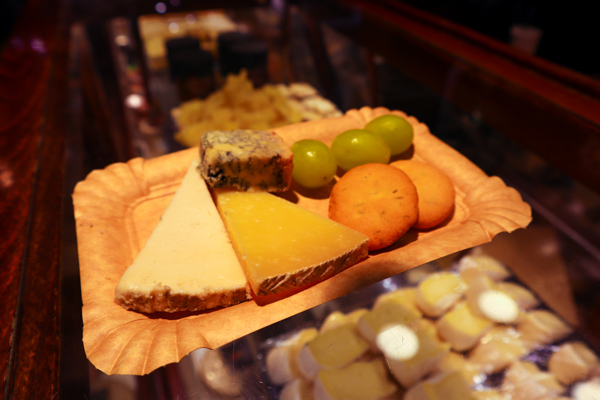
MYA SOURCES ITS WONDERFUL CHEESES FROM ALL OVER SPAIN—IN THIS PICTURE ALONE WE’VE GOT MADRID, ASTURIAS AND CASTILLA-LA MANCHA REPRESENTED.
3. La Casa del Bacalao
Madrid is home to some of the best seafood in Spain, much of which is available at La Casa del Bacalao. As the name implies, the salt cod is the star of the show at this stall. However, they also have everything from anchovies to octopus in case you’re in the mood for something else.
I got the bacalao con ajoarriero (salt cod with tomatoes and peppers) along with a smoked sardine tapa. The bacalao was nicely done and perfectly desalted, and the sardines were great as well. Considering that sardines are one of the most expensive canned goods to buy at a typical Spanish supermarket, you really get great value by enjoying them here.
Price: Tapas range from €1.00 to €1.50.

LA CASA DEL BACALAO IS THE PLACE TO GO FOR GREAT SEAFOOD TAPAS AT FAIR PRICES.
4. Mr. Pinkleton
Despite its English-sounding name, Mr. Pinkleton is as Spanish as it gets. This bar has an excellent selection of wines from all over the country, going for around €3.50 a glass. Again, not the cheapest glass of wine in Madrid—but a very fair price in terms of the experience you’re getting with it.
I had a glass of albariño, a white wine from Galicia, but this place also has a fantastic selection of sherries from Andalusia. And if the word “sherry” makes you picture a sickly sweet ebony wine your grandparents might drink, think again—some of the best sherries are actually pale in colour and very dry!
If you want to learn more about Spanish wines, watch my video about the top 5 Spanish wine styles you need to try in Spain.
Price: €3.50 for my white wine.
5. El Señor Martín
Out of all the stalls I visited in the Mercado San Miguel, this is the one that was hardest on my wallet. A tapa of boquerones fritos (fried anchovies) cost a whopping €14—about double what you’d pay for the same thing at a bar outside the market.
El Señor Martín does have great quality seafood. I could tell that the boquerones themselves were fresh, which was a good sign. However, they were very chewy and didn’t have that satisfying crunch that freshly fried fish usually does. Knowing that they weren’t cooked to order was a bit of a letdown, especially considering how much they cost.
The barman also gave me another tapa of squid tentacles that had just been battered and fried in the moment. These were much better, and proof that freshly cooked seafood is always better.
I hope this stall starts cooking to order. For the moment, I would avoid it – you can get fantastic boquerones fritos as many Madrid tapas bars for half the price.
Price: €14 for a serving of fried anchovies.
6. Arzábal
If the name Arzábal sounds familiar, you might be familiar with their brick-and-mortar bar in the Ibiza neighbourhood. Here, I got a tapa of patatas bravas for €7.
I had to wait about 10 minutes for my food, but that’s a good thing—they were making them fresh. The portion was a decent size for the price as well.
The potatoes were very well done, but the bravas sauce was a bit too watery and not spicy enough for my taste. Don’t get me wrong, these were authentic patatas bravas—just not my favourites!
If you want to know where to get the best bravas in Madrid, watch my video where my wife Yoly and I rank the 5 best patatas bravas in the capital.
Price €7 for a plate of patatas bravas
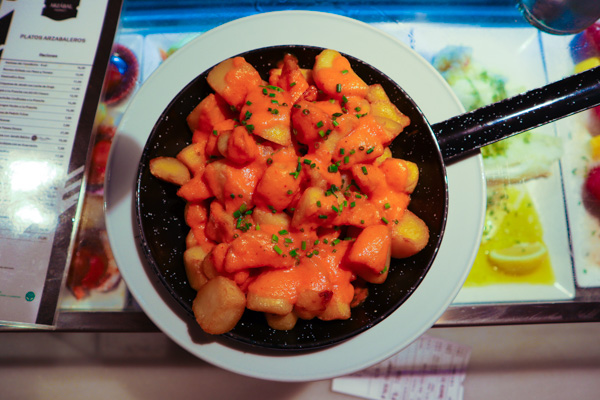
7. Amaiketako
One thing you’ll see a lot of at the Mercado de San Miguel are small tapas served on top of pieces of bread, sometimes held together by a toothpick. These are called “pintxos” (also spelled “pinchos”) and they’re typical of the Basque Country in northern Spain.
So what are they doing in Madrid?
Pintxos have become popular at the market because they’re small and easy to eat as you walk around.
Your best bet for pintxos at the Mercado de San Miguel is a place that doesn’t reheat theirs in the microwave. Amaiketako is one spot that comes to mind, which is where I went on this visit.
My first pintxo here was made with anchovy, boiled egg and chopped onion, with a bit of alioli on top. The second had artichoke and ham, and was heated up under the grill with a blowtorch—an interesting choice, and much better than using a microwave!
They also sell colourful tins of preserved goods from northern Spain, in case you’re looking for a unique gourmet souvenir, or something to eat back at the apartment.
Price: €3.00 – €3.50 per pincho
8. Paella Power
Take two of the most “touristy” things in Madrid—paella and the Mercado de San Miguel—and put them together. The final result is…not bad at all, actually.
It certainly helps that the mastermind behind Paella Power is Michelin-starred chef Rodrigo de la Calle. I could already tell this was going to be decent paella before I even tried it. They cook it in the correct kind of pan right out in the stall itself, so you can see the whole fascinating process. And with a finished paella coming out every 10–15 minutes, it’s guaranteed to be fresh.
The rice was al dente (as it should be) and full of flavour. I could tell it was made quickly as the stock was a bit overpowering, but overall it was a very well done paella.
A single serving of paella here costs €10, which brings up another good point. You’ll be hard-pressed to find a restaurant in Madrid serving up individual portions of paella that’s actually good. The minimum order is usually for at least two people and. However, since the paellas here are cooked in large batches and portioned out, this is a great option if you want to try Spain’s most famous rice dish without having to share.
Price: €10 for the smallest serving of paella (they have larger servings too, going up to €20.

THIS PAELLA WAS MADE IN THE TRADITIONAL VALENCIAN STYLE, WITH INGREDIENTS THAT INCLUDED CHICKEN AND GARROFÓN (SIMILAR TO LIMA BEANS).
9. Rocambolesc
After a delicious morning spent eating my way around the Mercado de San Miguel, it was time to wrap things up with dessert. I don’t have much of a sweet tooth, but I knew I had to try Rocambolesc, an artisanal gelato stand created by Michelin-starred pastry chef Jordi Roca.
The gelato itself was expertly made—creamy and not overpoweringly sweet—and can be embellished with a variety of toppings. If you’re in the mood for something different, they also sell pastries, chocolates and so much more at this dessert wonderland.
Price: €3.75 for my punnet of gelato with three toppings (they also do cones).
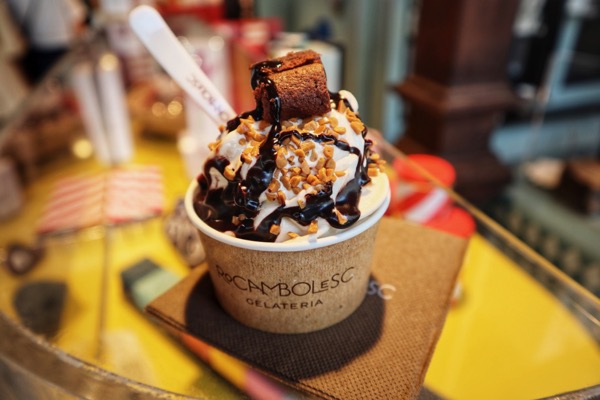
A GELATO FROM ROCAMBOLESC IS THE PERFECT WAY TO END YOUR TRIP TO THE MARKET.
Final Thoughts: Is the Mercado de San Miguel Worth It?
Absolutely—especially if you’re new to Spanish food.
Yes, some stalls are on the expensive side. But if this is your first time in Madrid or even in Spain, it’s a great jumping-off point into the world of tapas and local drinks. It’s the perfect starting point for your Madrid food adventure – but just make sure it’s not the ending point.
Get my FREE tapas mini-guide
If you’re travelling to Spain, remember to download my free guide to my favourite tapas bars in Madrid, Barcelona, Seville and San Sebastian! It’s a free PDF with my top 5 favourite tapas bars in each of those cities, plus other tips and tricks and recommendations. Salud!

